This article needs additional citations for verification .(February 2021) |
Ligonier Valley is a valley in Westmoreland County, Pennsylvania, United States.
This article needs additional citations for verification .(February 2021) |
Ligonier Valley is a valley in Westmoreland County, Pennsylvania, United States.
Around 1727 the first Native American settlement was made in the Ligonier Valley, near the confluence of Mill Creek and Loyalhanna Creek. The village was still relatively new when the first traders came in 1732.
In the next quarter-century the great struggle for mid-America developed between the English and the French. The showdown came in what is now known as the French and Indian War. In 1758 the English mounted a full-scale campaign. Gen. John Forbes commanded the expedition which drove through the woods and mountains of Pennsylvania, setting up a series of forts to strengthen his hand for the final blow: the attack on Fort Duquesne at the juncture of the Monongahela and Allegheny Rivers. One of the forts was named for the commander-in-chief of the British Army, Field Marshal Lord John Ligonier.
Alarmed at the approach of the British, the French and their Indian allies decided that the best defense was a good offense. On October 12, 1758, they attacked Fort Ligonier—approaching from the southwest. There were about 1,200 French soldiers and only a few hundred Indians. (Many of the Indians had returned home to prepare for the approaching winter.)
The French and Indians who attacked Fort Ligonier were under the command of DeVitri. They began firing at 11:00 am and the battle lasted until 3:00 pm After a spirited encounter, the French and Indians were beaten off with a heavy loss and they fled back to Duquesne. The British troops, under Gen. Forbes and Col. Washington, pressed on after the Ligonier victory; when they arrived at Duquesne, they found the fort afire. The victory at Ligonier was the turning point for the British. They established their own fort, named it for Prime Minister William Pitt, thus giving birth to the city of Pittsburgh. [1]
Fort Ligonier functioned for a few more years. Arrangements were made with Gen. Arthur St. Clair of the British Army, to serve as caretaker of the facility since he lived only a short distance away. Increasing ferocious Indian attacks during the American Revolution led to the construction of a second fort in 1777 (sometimes known as Fort Preservation). It was located somewhat east of the original fort and served as a refuge for the settlers. By the end of the Revolution, it had outlived its usefulness and was allowed to fall into disrepair. A few years later it disappeared altogether.

The French and Indian War (1754–1763) was a theater of the Seven Years' War, which pitted the North American colonies of the British Empire against those of the French, each side being supported by various Native American tribes. At the start of the war, the French colonies had a population of roughly 60,000 settlers, compared with 2 million in the British colonies. The outnumbered French particularly depended on their native allies.
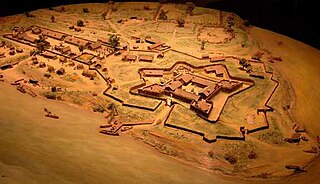
Fort Duquesne was a fort established by the French in 1754, at the confluence of the Allegheny and Monongahela rivers. It was later taken over by the British, and later the Americans, and developed as Pittsburgh in the U.S. state of Pennsylvania. Fort Duquesne was destroyed by the French before its British conquest during the Seven Years' War, known as the French and Indian War on the North American front. The British replaced it, building Fort Pitt between 1759 and 1761. The site of both forts is now occupied by Point State Park, where the outlines of the two forts have been laid in brick.

Fort Prince George was an uncompleted fort on what is now the site of Pittsburgh, at the confluence of the Allegheny and Monongahela Rivers in Allegheny County, Pennsylvania. The site was originally a trading post established by Ohio Company trader William Trent in the 1740s. Construction of Fort Prince George, named for the crown prince and later King George III), was begun in January 1754 by 41 Virginians. The plan to occupy the strategic forks was formed by Virginia Lieutenant Governor Robert Dinwiddie, on the advice of Lieutenant Colonel George Washington, whom Dinwiddie had sent on a mission to warn French commanders they were on English territory in late 1753, and had made a military assessment of the site. Captain Trent commanded the force constructing the fort, but his men were captured by 1,000 French soldiers and Indians led by Claude-Pierre Pécaudy de Contrecœur. At the time of the French arrival, Trent was at Wills Creek for a conference, while his second-in-command, Lieutenant John Fraser, was at his own plantation at Turtle Creek on the Mononghela River. Ensign Edward Ward was left to surrender the fort on April 18, 1754. The French attack was the hostile act of the war, and it led to George Washington's own surprise attack at the Battle of Jumonville Glen.
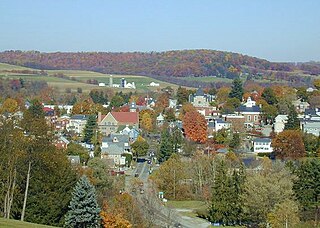
Ligonier is a borough in Westmoreland County, Pennsylvania, United States. The population was 1,513 at the 2020 census. Ligonier was settled in the 1760s. The borough is well known for nearby Idlewild Park, one of the oldest amusement parks in the country; and nearby Seven Springs Mountain Resort. Another tourist attraction is Fort Ligonier Days, a parade and craft market that takes place every fall over the course of three days, and the Ligonier Country Market in the summer months. Ligonier is part of the Pittsburgh Metropolitan Statistical Area.

John Forbes was a Scottish professional soldier who served in the British Army from 1729 until his death in 1759.
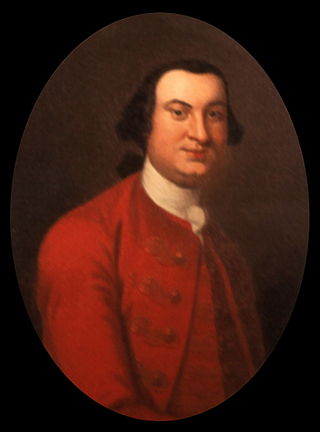
Henry Bouquet was a Swiss mercenary who rose to prominence in British service during the French and Indian War and Pontiac's War. He is best known for his victory over a Native American force at the Battle of Bushy Run, lifting the siege of Fort Pitt during Pontiac's War. During the conflict Bouquet gained lasting infamy in an exchange of letters with his commanding officer, Jeffery Amherst, who suggested a form of biological warfare in the use of blankets infected with smallpox which were to be distributed to Native Americans. Despite this indictment historians have praised Bouquet for leading British forces in several demanding campaigns on the Western Frontier in which they "protected and rescued" settlers from increasingly frequent attacks.
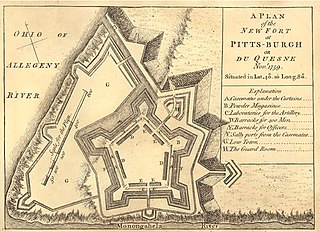
Fort Pitt was a fort built by British forces between 1759 and 1761 during the French and Indian War at the confluence of the Monongahela and Allegheny rivers, where the Ohio River is formed in western Pennsylvania. It was near the site of Fort Duquesne, a French colonial fort built in 1754 as tensions increased between Great Britain and France in both Europe and North America. The French destroyed Fort Duquesne in 1758 when they retreated under British attack.

The Battle of Fort Duquesne was a British assault on the eponymous French fort that was repulsed with heavy British losses on 14 September 1758, during the French and Indian War.
Thomas Bullitt was a United States military officer from Prince William County, Virginia and pioneer on its western frontier.
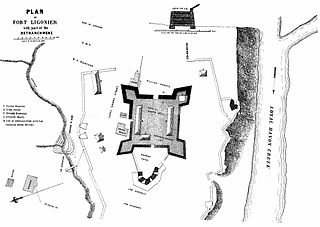
The Battle of Fort Ligonier was a battle of the French and Indian War. On 12 October 1758, French and Indian forces directed from nearby Fort Duquesne were repulsed in an attack on the British outpost of Fort Ligonier, then still under construction.
Fort Bedford was a French and Indian War-era British military fortification located at the present site of Bedford, Pennsylvania. The fort was a star-shaped log fortress erected in the summer of 1758.

Fort Ligonier is a British fortification from the French and Indian War located in Ligonier, Pennsylvania, United States. The fort served as a staging area for the Forbes Expedition of 1758. During the eight years of its existence as a garrison, Fort Ligonier was never taken by an enemy. It served as a post of passage to the new Fort Pitt, and during Pontiac's War of 1763, was a vital link in the British communication and supply lines. It was attacked twice and besieged by the Native Americans, prior to the decisive victory at Bushy Run in August of that year. The fort was decommissioned from active service in 1766. Today, there is a museum next to the reconstructed fort. Inside the museum there are artifacts from the battle. An individual can take a guided tour of the fort, and on Fort Ligonier Days, the fort's cannons are fired.

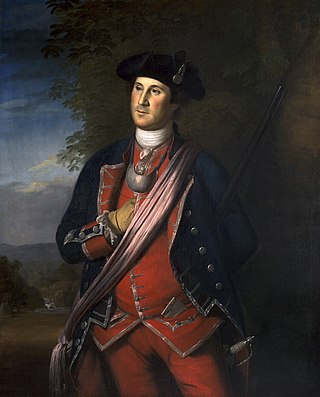
George Washington's military experience began in the French and Indian War with a commission as a major in the militia of the British Province of Virginia. In 1753 Washington was sent as an ambassador from the British crown to the French officials and Indians as far north as present-day Erie, Pennsylvania. The following year he led another expedition to the area to assist in the construction of a fort at present-day Pittsburgh, Pennsylvania. Before reaching that point, he and some of his men, along with Mingo allies led by Tanacharison, ambushed a French scouting party. Its leader was killed, although the exact circumstances of his death were disputed. This peacetime act of aggression is seen as one of the first military steps leading to the global Seven Years' War. The French responded by attacking fortifications Washington erected following the ambush, forcing his surrender. Released on parole, Washington and his troops returned to Virginia.

James Burd was a colonial American soldier in the French and Indian War, during which he played an important role in fortifying the Pennsylvania frontier.

Fort Pitt Museum is an indoor/outdoor museum that is administered by the Senator John Heinz History Center in downtown Pittsburgh, Allegheny County, Pennsylvania in the United States. It is at the confluence of the Monongahela and Allegheny Rivers, where the Ohio River is formed. Fort Pitt Museum is surrounded by Point State Park, a Pennsylvania state park named for the geographically and historically significant point that is between the rivers. This piece of land was key to controlling the upper reaches of the Ohio River Valley and western Pennsylvania, before, during and after the French and Indian War as well as the American Revolution.

The Forbes Expedition was a British military expedition to capture Fort Duquesne, led by Brigadier-General John Forbes in 1758, during the French and Indian War. While advancing to the fort, the expedition built the now historic trail, the Forbes Road. The Treaty of Easton served to cause a loss of Native American support for the French, resulting in the French destroying the fort before the expedition could arrive on November 24.
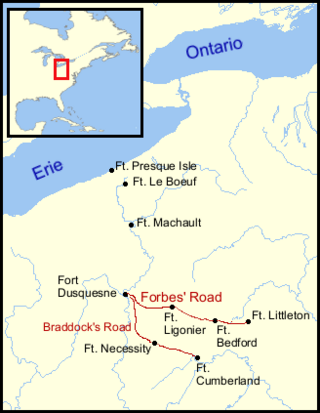
The Forbes Road, a historic military roadway in what was then British America, was initially completed in 1758 from Carlisle, Pennsylvania, to the French Fort Duquesne at the junction of the Allegheny and Monongahela rivers in what is now downtown Pittsburgh, via Fort Loudon, Fort Littleton, Fort Bedford and Fort Ligonier. The road, initially about 220 miles long, was named for Brigadier General John Forbes, the commander of the 1758 British-led expedition that built the road during the French and Indian War. The Forbes Road and Braddock's Road were the two main land routes that the British cut west through the wilderness during the war. The task was complicated by the Appalachian Mountains' steep northeast-to-southwest ridges, a generally broken terrain between the ridges, heavy forestation, and numerous swamps and rivers.
Fort Juniata Crossing, also known as Fort Juniata or simply Juniata Crossing, was a British French and Indian War era fortification located along the Forbes Road. The fort was located along a strategic ford of the Raystown Branch of the Juniata River about 2.4 miles (3.9 km) west of the current site of Breezewood, Pennsylvania.

Kuskusky, also known as the Kuskuskies Towns, Kuskuskie Towns, or Kuskuskies' Indian Town, with a wide variety of other spellings, were several Native American communities inhabited near New Castle, Mahoning, and Edinburg, Pennsylvania, and Youngstown, Ohio, during the mid-18th century. It was not one town, but three or four contiguous towns of the Mingoes, Lenape, and Seneca, located along the Beaver River, at and above the junction of its east and west branches, the Mahoning River and the Shenango River. It is usually referred to in the plural.